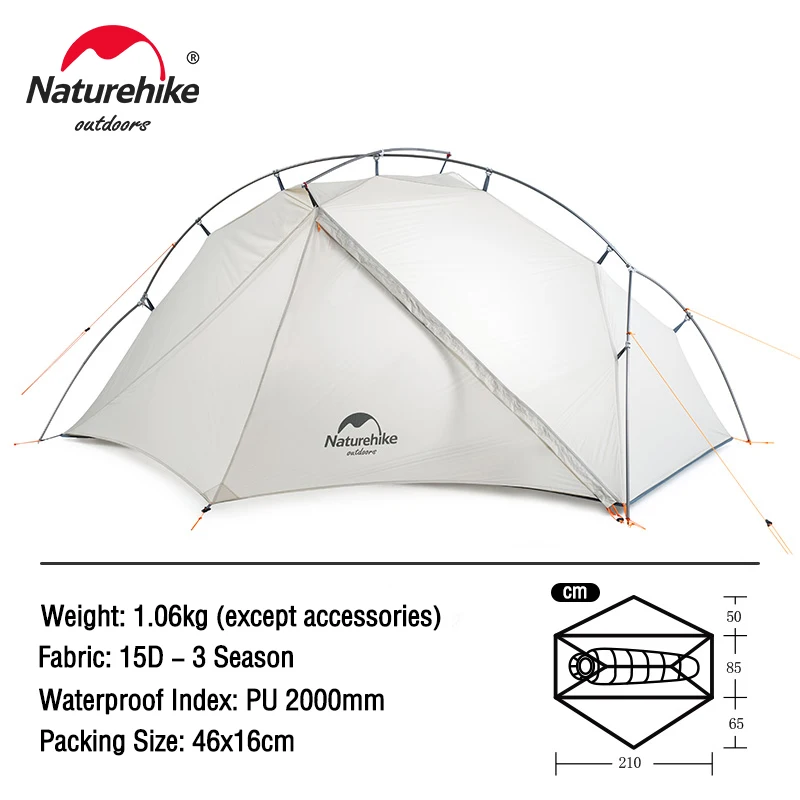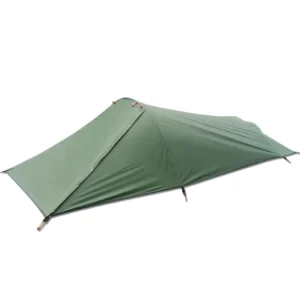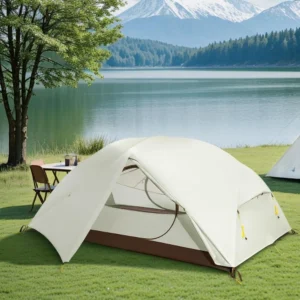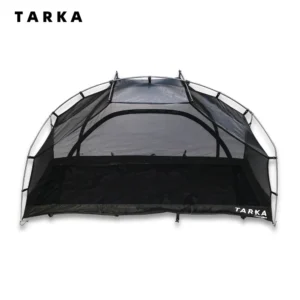Introduction: Why a Quality Insulated Tent is Essential for Cold Weather Adventures
Winter camping brings breathtaking landscapes and peaceful solitude, but it also presents unique challenges that require specialized gear. An insulated tent isn’t just a convenience in cold weather—it’s a crucial safety component that can make the difference between an enjoyable adventure and a dangerous situation.
What makes a tent “winter-ready” or “insulated” goes beyond basic shelter. True cold weather tents feature:
- Double-wall construction that traps air for better temperature regulation
- Specialized fabrics with lower breathability to retain heat
- Minimal mesh panels to reduce heat loss
- Robust pole structures designed to withstand snow loads and high winds
When temperatures plummet below freezing, ordinary tents simply can’t provide the protection you need. Winter hikers face extreme conditions including subzero temperatures, howling winds, heavy snow accumulation, and dangerous condensation that can soak sleeping bags and clothing.
Understanding compact shelters for two campers provides fundamental knowledge that applies directly to selecting appropriate winter options. For those specifically planning trips in high-elevation settings, knowing the requirements for compact winter tents for alpine hiking becomes even more crucial.
This guide will help you navigate the specialized world of winter tents, comparing essential features and highlighting the best options for different cold weather adventure scenarios. Whether you’re planning a quick weekend trip or a serious mountaineering expedition, choosing the right shelter can transform your winter experience.
Quick Comparison: Top Insulated Tents for Winter Adventures
Before diving into detailed reviews, here’s a comprehensive comparison of our top winter tent selections. These models represent the best balance of insulation, weather resistance, durability, and practical features for cold weather hiking across various scenarios and budgets.
Our selection methodology prioritized tents that have proven their worth in genuine winter conditions, with special attention to insulation properties, structural integrity under snow loads, and condensation management. We’ve personally tested these models or consulted with expedition leaders who have used them in extreme environments.
Winter tents typically command higher prices than their 3-season counterparts due to more robust materials and construction—an investment that pays dividends in safety and comfort when temperatures drop. The options below span various price points while maintaining essential cold-weather performance standards.
Explore our 4-season winter 2-person tents collection for a complete range of options suitable for cold weather expeditions.
Best Overall Winter Tent: The Ultimate Balance of Protection and Practicality
Key Specifications:
– Weight: 7 lbs 8 oz (3.4 kg)
– Capacity Options: 2-3 person
– Materials: 70D nylon with silicone/PU coating (5000mm)
– Packed Size: 7” x 19” (18cm x 48cm)
This tent strikes the perfect balance between bombproof protection and practical usability. Its geodesic dome design creates exceptional structural stability that stands firm even under significant snow loads and winds exceeding 40 mph. The double-wall construction works brilliantly to manage the critical balance between insulation and ventilation.
What truly sets this tent apart is its thoughtful design for winter use. The bathtub floor extends high up the sidewalls to prevent snow drift infiltration, while the two vestibules offer ample storage for winter gear and even allow for protected cooking in harsh conditions.
The tent’s ventilation system deserves special mention—strategically placed vents with adjustable closures allow you to fine-tune airflow based on conditions, dramatically reducing the condensation issues that plague lesser winter tents.
Despite its robust protection, setup remains manageable even with gloves on, taking approximately 5-7 minutes once you’re familiar with the process. Color-coded poles and clip attachments simplify the process in challenging conditions.
For those seeking serious winter protection with reasonable weight considerations, our heavy duty 4-season tent options provide exceptional durability against the harshest elements.
Pros:
– Exceptional stability in high winds and heavy snow
– Excellent condensation management
– Spacious vestibules for gear storage
– Relatively easy setup considering its winter capabilities
– Durable materials that withstand harsh conditions
Cons:
– Heavier than summer backpacking tents
– Premium price point
– Overkill for mild winter conditions
Best Ultralight Option for Winter Backpacking: When Weight Matters Most
Key Specifications:
– Weight: 4 lbs 2 oz (1.87 kg)
– Capacity: 2 person
– Materials: 30D ripstop nylon, DAC Featherlite poles
– Packed Size: 6” x 18” (15cm x 46cm)
When every ounce matters but winter protection remains non-negotiable, this ultralight winter tent delivers remarkable performance. Weighing just over 4 pounds, it’s nearly 40% lighter than traditional 4-season options while maintaining essential cold weather functionality.
This weight reduction comes primarily through strategic material selection—30D ripstop nylon instead of heavier fabrics, minimalist but functional vestibules, and an innovative pole structure that maintains strength while reducing weight. The tent employs a hybrid single/double wall design that manages to balance weight savings with reasonable condensation control.
The tent excels in moderate winter conditions—temperatures down to about 10°F (-12°C) with moderate snowfall and winds up to 30 mph. Beyond these parameters, you’ll start noticing its compromises compared to heavier options. The streamlined design makes it particularly suitable for alpine approaches and backcountry ski touring where weight savings translate directly to energy conservation.
Setup requires more attention to detail than heavier models, with less margin for error in stake placement and tensioning, but can be accomplished in approximately 4-6 minutes in good conditions.
For those prioritizing minimum pack weight, explore our complete ultralight backpacking tent selection for options that can be adapted to winter use when paired with proper techniques.
Pros:
– Remarkably lightweight for a winter-capable tent
– Excellent packed size for limited backpack space
– Adequate protection for moderate winter conditions
– Faster setup than most 4-season designs
Cons:
– Less suitable for extreme conditions
– Reduced vestibule space
– Requires more careful site selection
– Higher condensation potential than heavier options
Best for Extreme Cold & Mountaineering Expeditions: No-Compromise Protection
Key Specifications:
– Weight: 9 lbs 6 oz (4.25 kg)
– Capacity Options: 2-3 person
– Materials: 75D ripstop polyester with 10,000mm waterproof rating
– Packed Size: 8” x 22” (20cm x 56cm)
This expedition-grade tent represents the pinnacle of winter protection, designed specifically for the most extreme environments on earth. Its robust six-pole structure creates an exceptionally stable dome that has been proven in high-altitude camps and polar expeditions where failure isn’t an option.
The tent’s construction prioritizes absolute reliability with reinforced pole sleeves rather than clips, creating an integrated structure that distributes stress evenly across the tent body. The 75D fabric provides exceptional tear strength and abrasion resistance, while multiple guy-out points with reinforced attachment zones secure the tent against sustained high winds.
Ventilation receives special attention with adjustable cross-ventilation channels that function even when completely surrounded by snow. The oversized vestibule accommodates extensive expedition gear and can be configured as a protected cooking space—a critical feature for multi-day winter journeys.
Despite its fortress-like construction, the intuitive color-coding and logical setup sequence mean it can be pitched in approximately 7-9 minutes, even in challenging conditions when following the mastering two-person lightweight tent setup techniques adapted for winter use.
This tent excels in extreme scenarios—high-altitude mountaineering, extended winter expeditions, and locations where weather conditions can deteriorate rapidly. Its temperature performance remains stable in conditions well below zero, with users reporting comfortable use in temperatures approaching -40°F/C.
Pros:
– Unmatched stability in extreme conditions
– Superior snow-load capacity
– Excellent ventilation despite robust insulation
– Spacious design accommodates winter gear
– Proven in the world’s harshest environments
Cons:
– Heavy for backpacking
– Expensive investment
– Requires more setup time
– Excessive for casual winter camping
Best Value Winter Tent: Performance on a Budget
Key Specifications:
– Weight: 6 lbs 14 oz (3.12 kg)
– Capacity: 2 person
– Materials: 68D polyester with 3000mm waterproof rating
– Packed Size: 7” x 20” (18cm x 51cm)
Finding a true winter-worthy tent at a moderate price point is challenging, but this model delivers remarkable performance without breaking the bank. It smartly focuses resources on essential winter features while making calculated compromises in areas less critical to cold weather performance.
The tent employs a modified dome structure with additional crossing poles for improved stability under snow loads. While not quite as bombproof as premium alternatives, it handles moderate snowfall and winds up to approximately 35 mph with proper guying—more than adequate for most winter backpacking scenarios below treeline.
The primary cost savings come from slightly less premium materials—68D polyester rather than more expensive nylons, and aluminum poles that are durable but slightly heavier than high-end alternatives. The floor uses a higher denier fabric to maintain durability where it matters most.
Ventilation is surprisingly effective through two adjustable roof vents, though the system requires more manual management than premium models. The vestibule space is adequate though not expansive, accommodating essential winter gear with careful organization.
For those exploring mountain environments specifically, our mountaineering tent collection offers specialized designs for alpine conditions at various price points.
Pros:
– Excellent value for genuine winter capability
– Reliable protection in moderate winter conditions
– Reasonable weight for the protection offered
– Good ventilation system for condensation control
Cons:
– Less suitable for extreme conditions
– Heavier than premium ultralight options
– Smaller vestibule space
– Requires more careful site selection in harsh conditions
Best for Group Winter Camping & Basecamps: Spacious Cold Weather Shelters
Key Specifications:
– Weight: 13 lbs 8 oz (6.12 kg)
– Capacity: 4-6 person
– Materials: 70D nylon with 5000mm waterproof rating
– Packed Size: 10” x 24” (25cm x 61cm)
Winter camping with a group presents unique challenges—more people generate more heat and moisture while requiring more sheltered space for gear and communal activities. This spacious winter shelter excels in basecamp scenarios where comfort and livability take priority over extreme portability.
The extended dome design creates an impressive 64 square feet of protected floor space with a peak height of 50 inches—allowing comfortable sitting space for group planning sessions or waiting out storms. The structure employs a robust five-pole system that maintains stability despite its larger footprint, handling significant snow loads when properly set up.
What truly distinguishes this tent for group use is its vestibule system—a massive 27 square foot front vestibule creates protected space for gear storage and food preparation, while a smaller rear vestibule offers secondary access and additional storage. This configuration prevents the main living area from becoming cluttered with wet gear.
Ventilation receives appropriate scaling for increased occupancy, with adjustable panels at both ends and near the peak. This system effectively manages the substantially higher moisture output from multiple occupants, maintaining a drier interior environment even when fully occupied.
When shared among group members, the weight becomes quite manageable at approximately 3.4 pounds per person for a four-person expedition. The design shows thoughtful consideration for camping shelter options for two or more people, with internal organization that facilitates group living.
Pros:
– Spacious interior for genuine comfort
– Excellent vestibule system for group gear
– Good headroom for extended livability
– Effective ventilation scaled for higher occupancy
– Manageable weight when distributed among group
Cons:
– Too heavy for solo use
– Requires larger tent platforms or clearings
– More challenging setup in windy conditions
– Significant packed size
Best for Fast & Light Winter Assaults: When Speed is Critical
Key Specifications:
– Weight: 3 lbs 10 oz (1.64 kg)
– Capacity: 2 person (snug)
– Materials: 20D ripstop nylon with Silicone/PU coating
– Packed Size: 5” x 17” (13cm x 43cm)
For alpine starts, summit bids, and scenarios where every minute and ounce counts, this specialized single-wall design delivers remarkable protection at a fraction of the weight. Using a hybrid design that minimizes weight while maintaining essential winter functionality, this tent represents the cutting edge of fast-and-light winter shelter technology.
The streamlined single-wall construction eliminates the separate rainfly, instead using a waterproof-breathable fabric technology similar to hardshell jackets. This design dramatically reduces weight and setup complexity, allowing deployment in under 3 minutes—critical when racing approaching weather or setting up on exposed terrain.
The pole structure uses a minimalist yet effective design with two crossing poles and a short ridge pole, creating adequate stability for moderate snow loads and winds while keeping weight minimal. Strategic reinforcement points handle stresses where they concentrate most.
Ventilation—typically the Achilles heel of single-wall tents—receives special attention with protected venting ports that can remain partially open even during precipitation. Condensation remains more problematic than in double-wall designs but is manageable with proper techniques and expectations.
The interior is admittedly snug for two occupants with winter gear, requiring careful organization and coordination. However, this tent isn’t designed for extended comfort—it excels in scenarios where protection from the elements must be balanced against speed and weight considerations.
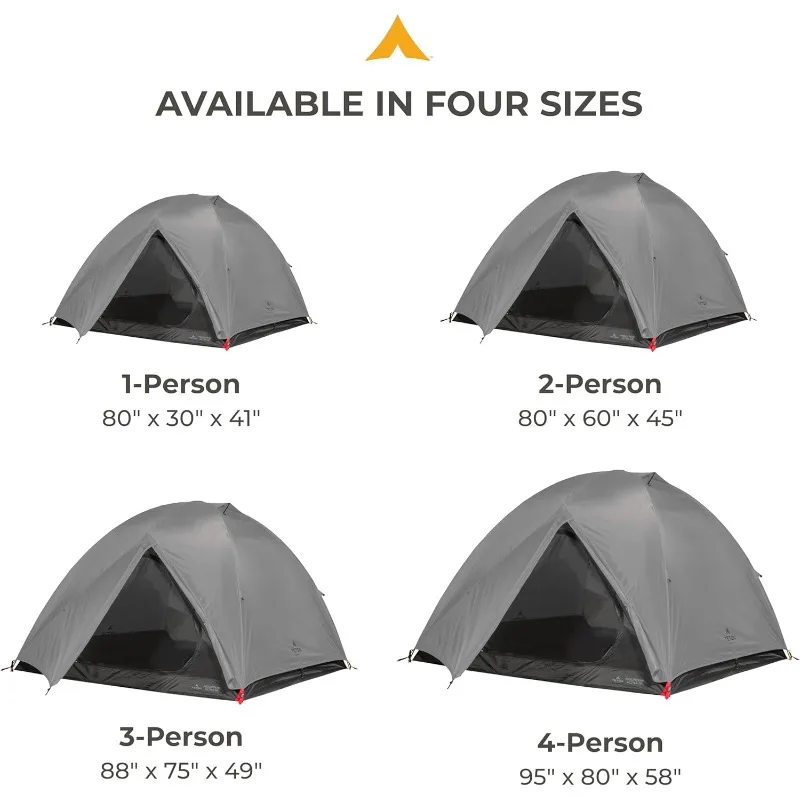
For more winter-specific shelter options across different designs and capacities, our winter camping tent collection offers specialized features for cold weather adventures.
Pros:
– Exceptionally lightweight for winter protection
– Remarkably fast setup
– Minimal packed size
– Adequate protection for moderate winter conditions
– Perfect for alpine-style missions
Cons:
– Limited interior space
– Higher condensation potential
– Less suitable for extended stays
– Requires more careful site selection
– Less durable than heavier options
Understanding Insulation & Essential Features for Cold Weather Tents
Cold weather tents don’t technically provide “insulation” in the same way your jacket or sleeping bag does. Instead, they create a critical microclimate by blocking wind, shedding precipitation, and containing some of your body heat. Understanding this distinction helps set realistic expectations and guides proper winter camping techniques.
The primary insulation difference between summer and winter tents comes from construction design rather than magical warming properties:
Double-wall vs. Single-wall Construction
Double-wall tents feature an inner tent body plus a separate rainfly, creating a dead air space that acts as a thermal buffer. This design significantly reduces condensation by allowing moisture to escape the inner tent while preventing precipitation from entering. Single-wall tents combine these layers, saving weight but typically managing moisture less effectively.
Fabric Technology and Heat Retention
Winter tents generally use denser fabrics with less mesh, reducing airflow and retaining slightly more warmth. However, these materials primarily enhance weather resistance and durability rather than providing true insulation. Silicone-treated nylons and polyesters with higher denier counts (70D+) offer superior strength for snow loads while maintaining reasonable weight.
Understanding comprehensive approaches to mastering tent insulation for year-round camping helps maximize the performance of any winter shelter system. The most effective approach combines proper tent selection with appropriate sleeping equipment—the tent creates the protected microclimate, while your sleeping bag and pad provide actual insulation for your body.
The 4-Season Rating Explained: What It Really Means for Winter Hikers
The term “4-season tent” often creates confusion for hikers transitioning to winter camping. Despite the name suggesting year-round versatility, these tents are actually specialized tools optimized for winter conditions, sometimes at the expense of summer comfort.
True 4-season tents differ from 3-season models in several crucial ways:
– Stronger pole structures (often geodesic designs) to withstand snow loading
– More robust materials to handle abrasion from ice and frozen equipment
– Less mesh and more solid fabric to block wind and retain some warmth
– Steeper wall angles to shed snow more effectively
– Larger vestibules to accommodate bulkier winter gear
Contrary to common belief, 4-season tents aren’t necessarily warmer—they’re primarily designed to withstand harsher conditions. In fact, many 4-season tents become uncomfortably hot and condensation-prone in summer due to reduced ventilation.
Within the 4-season category, you’ll find specialized subtypes:
– Mountaineering/Expedition tents (maximum strength, moderate weight)
– Winter backpacking tents (balanced protection and portability)
– Basecamp tents (maximize livability, less concern for weight)
For winter hikers, the critical question isn’t whether you need a 4-season tent, but rather what severity of conditions you’ll face. Weekend trips in moderate winter conditions might be manageable with a robust 3-season tent, while any exposure to significant snow loads, high winds, or extreme cold demands a true 4-season design.
When choosing the ultimate compact shelter for two, winter conditions introduce additional considerations that significantly narrow the field of appropriate options.
Critical Design Elements That Define Cold Weather Performance
Understanding the technical features that differentiate winter tents helps you make informed choices based on your specific needs rather than marketing claims. These design elements work together to create a shelter system capable of withstanding harsh winter conditions.
Pole Structure: The Skeleton of Winter Protection
The pole configuration largely determines a tent’s ability to handle snow loads and wind pressure. Winter-specific designs typically feature:
– Geodesic or modified dome structures that distribute stress evenly
– Additional crossing poles for increased stability
– Shorter pole segments with larger diameters for strength
– Premium aluminum alloys (7000-series) or carbon composite materials
– Interconnected hub systems that prevent individual pole failure
Fabric Selection: The Shield Against Elements
Winter tent fabrics balance durability, weather resistance, and weight:
– Higher denier ratings (70D+) for improved tear strength and puncture resistance
– Tighter weave patterns that enhance wind resistance
– Silicone impregnation for increased strength and water shedding
– Higher hydrostatic head ratings (4000mm+) to prevent moisture penetration
– Strategic reinforcement in high-stress zones
Ventilation Systems: Battling the Condensation Enemy
Counterintuitively, effective ventilation becomes more critical in winter tents:
– Adjustable vents positioned to create circulating airflow
– Protected vent designs that function during active precipitation
– Separation between inner tent and fly to create thermal buffer zones
– Door designs that allow partial opening for air exchange while maintaining protection
Vestibule Design: Your Winter Command Center
Winter camping requires more protected external space:
– Extended vestibule designs that accommodate bulky gear
– Multi-point adjustment systems for tailoring to conditions
– Reinforced ground attachments to prevent snow collapse
– Optional snow flaps that can be buried to seal against drafts
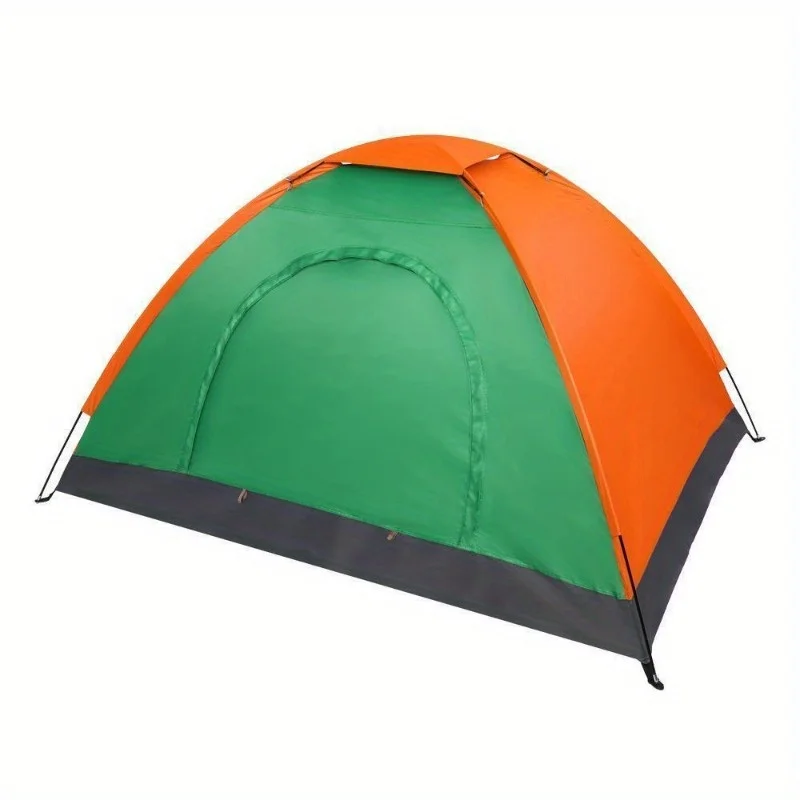
The Truth About Tent Warmth: It’s All About Your Sleep System
Perhaps the most common misconception about winter camping is that the tent itself provides significant warmth. In reality, your tent primarily offers protection from wind, precipitation, and ambient moisture—creating a stable environment for your true insulation: your sleep system.
The foundation of winter warmth begins with preventing heat loss to the ground. Your sleeping pad’s R-value (thermal resistance) is arguably more important than your sleeping bag’s temperature rating. For winter camping:
– Look for sleeping pads with R-values of 5+ for freezing conditions
– Consider combining pads (closed-cell foam under an inflatable) for maximum insulation
– Extend pad coverage under your entire body including arms and head
Your sleeping bag works in concert with your pad, creating a complete thermal envelope:
– Choose a temperature rating at least 10°F below expected nighttime lows
– Consider the difference between “comfort” and “survival” ratings
– Remember that manufacturer ratings assume you’re using an appropriate pad
Additional winter sleep system considerations include:
– Using a sleeping bag liner can add 5-15°F of additional warmth
– Wearing a clean, dry base layer (not your hiking clothes) inside your bag
– Keeping a dedicated pair of sleep socks that never leave the tent
By understanding that your tent creates the protected space while your sleep system provides the actual insulation, you can make better gear choices and avoid the discomfort of unrealistic expectations.
Balancing Act: Weight vs. Protection for Winter Backpacking
Every winter backpacker faces the fundamental dilemma of balancing adequate protection against reasonable pack weight. There’s no universal “right answer” to this equation—the optimal balance depends on your specific trip parameters, personal risk tolerance, and environmental conditions.
When evaluating this trade-off, consider these guidelines:
– Trip duration dramatically impacts acceptable weight—an extra pound feels minimal on a weekend trip but becomes significant on a week-long expedition
– Forecasted conditions should drive your decisions—milder, more predictable weather allows lighter gear choices
– Proximity to safety/civilization affects appropriate risk tolerance—remote locations demand more robust protection
– Group size influences options—sharing components among multiple hikers can allow bringing a slightly heavier but more protective shelter
Material choices represent the most visible aspect of this balance:
– Fabric weight (measured in denier) directly correlates with durability and puncture resistance
– Pole materials range from basic aluminum to premium carbon fiber with corresponding weight differences
– Single-wall designs save weight but typically handle condensation less effectively
Remember that your tent represents emergency life support in winter conditions—this is rarely the best category for aggressive weight-saving measures. Most experienced winter backpackers err slightly toward protection over minimum weight after learning from uncomfortable (or dangerous) experiences.
Finding Your Ideal Tent Size: Winter-Specific Considerations
Winter camping demands different spatial considerations than summer adventures. Cold weather gear is bulkier, conditions often force more time inside the tent, and keeping equipment organized becomes more crucial for comfort and safety.
When selecting a winter tent capacity:
– Size up from your typical 3-season choice—a 2-person winter tent might feel cramped for two people with winter gear
– Calculate approximately 20-30% more floor space than summer camping requirements
– Consider interior height carefully—you need adequate space to change clothes without contacting tent walls
– Remember that steeper winter tent walls may reduce usable floor space
Vestibule requirements also increase significantly:
– Plan for storing snow-covered boots, gaiters, and outer layers
– Allow space for basic cooking operations during storm conditions
– Consider whether you need storage for technical equipment like snowshoes or skis
The question of what size tent is good for 2 people becomes particularly relevant in winter when gear volume expands significantly while the need for efficient body heat management increases. For true winter camping, many experienced duos opt for 3-person models to accommodate their expanded gear requirements.
Real-World Applications: Matching Tents to Winter Adventures
Different winter scenarios demand different shelter solutions. Here’s how to match specific adventure types with the most appropriate tent characteristics:
Solo Weekend Winter Backpacking
Prioritize a balance of protection and weight with a lightweight 4-season design. Look for models under 5 pounds with adequate vestibule space for solo gear. Setup simplicity becomes important when managing the entire camp establishment process alone.
Multi-Day Group Expeditions
Focus on livability and storm worthiness over minimum weight. Larger vestibules, more interior organization options, and robust snow-shedding designs pay dividends during extended trips. Consider models that allow cooking in vestibules during prolonged storms.
Lightweight Backpacking Tent, Ultralight Backpacking Tent, Ultralight Bivy Tent
Ultralight Single Person Camping Tent with Aluminum Poles for 3-Season Backpacking Waterproof DesignPrice range: $94.88 through $326.82 Select options This product has multiple variants. The options may be chosen on the product pageLightweight Backpacking Tent, Ultralight Backpacking Tent, Waterproof Backpacking Tent
$391.05 Select options This product has multiple variants. The options may be chosen on the product pageHeavy Duty 4 Season Tent, Mountaineering Tent, Winter Camping Tent
$870.40 Select options This product has multiple variants. The options may be chosen on the product pageUltralight Backpacking Tent, Ultralight Dome Tent, Winter Camping Tent
Price range: $369.63 through $370.07 Select options This product has multiple variants. The options may be chosen on the product pageHeavy Duty 4 Season Tent, Ultralight Freestanding Tent, Winter Camping Tent
$3,722.66 Select options This product has multiple variants. The options may be chosen on the product pageUltralight Backpacking Tent, Ultralight Trekking Pole Tent
Price range: $350.87 through $351.98 Select options This product has multiple variants. The options may be chosen on the product page
Alpine Climbing and Mountaineering
Prioritize strength-to-weight ratio and rapid deployment features. Look for designs with multiple guy-out points, reinforced anchoring systems, and the ability to pitch in confined spaces on uneven terrain. Consider single-wall designs if weight savings are crucial.
Base Camp Operations
When weight is less constrained, maximize comfort with larger dome designs featuring multiple doors and vestibules. Extended peak height improves livability during storm days, while robust pole structures ensure security during extended unattended periods.
Winter Through-Hiking
Balance is key—look for designs that sacrifice some storm worthiness for weight savings but maintain essential winter features. Consider hybrid single/double wall designs and slightly reduced material weights that maintain adequate protection.
Essential Techniques for Winter Tent Survival
Even the best winter tent requires proper techniques to perform optimally in challenging conditions. Mastering these skills transforms your shelter from merely adequate to genuinely comfortable.
Strategic Site Selection
– Choose locations with natural wind protection when possible
– Look for flat areas where snow can be properly compacted
– Avoid depressions that can collect cold air
– Consider avalanche risk and tree hazards carefully
– Orient your tent entrance away from prevailing winds
Snow Anchoring Mastery
– Use buried objects (stuff sacks filled with snow) as deadman anchors
– Allow snow anchors 15-30 minutes to freeze and strengthen after placement
– Carry aluminum stakes specifically designed for snow
– Use trekking poles, ice axes, or snowshoes as supplementary anchors
Vestibule Management
– Create a designated storage system for wet vs. dry gear
– Dig out the vestibule area to increase usable space
– If cooking in vestibules, maintain adequate ventilation and clearance from tent fabrics
– Establish clear entry/exit protocols to minimize snow introduction
Condensation Prevention
– Ventilate aggressively whenever conditions allow
– Avoid bringing snow-covered items inside the main tent body
– Shake out clothing before bringing it into sleeping areas
– Consider using a small cloth to wipe down interior walls in the morning
What to Avoid: Common Mistakes When Choosing Winter Tents
Many winter camping challenges stem from common equipment selection errors. Avoid these typical mistakes:
• Insufficient weather resistance – Tents with excessive mesh panels or minimal rainfly coverage can’t be adequately sealed against driving snow and wind
• Inadequate vestibule space – Winter gear volume increases dramatically; insufficient protected storage space creates organizational nightmares
• Over-reliance on stakes – Winter tents should have multiple securing options including deadman anchors, snow stakes, and guy lines
• Single-wall designs without adequate ventilation – The condensation management challenge multiplies in cold conditions where moisture freezes rather than evaporating
• Ultra-thin floors – Winter camping often occurs on rough, frozen surfaces that demand more floor durability than summer conditions
• Complex setup mechanisms – Designs requiring fine motor skills become problematic with gloved hands in cold conditions
• Budget prioritization of features over quality – Core winter tent functions (stability, weather resistance) should never be compromised for accessory features
Winter Tent Maintenance: Extending the Life of Your Investment
Quality winter tents represent a significant investment that can deliver decades of service with proper care. Protect your equipment with these maintenance practices:
Field Care Essentials
– Brush off snow before packing whenever possible
– Avoid folding in the same creases repeatedly, especially in extreme cold
– Never force frozen zippers—warm them with body heat first
– Use tent-compatible lubricant on zippers regularly in winter conditions
Post-Trip Protocols
– Always dry completely before storage—set up in a garage or basement if needed
– Clean with gentle non-detergent soap only when necessary
– Inspect seam tape and apply seam sealer to damaged areas
– Check and tighten any loose guy line attachments
Long-Term Storage
– Store loosely in a cotton or mesh bag, never compressed
– Keep in a cool, dry place away from direct sunlight
– Avoid storing in plastic containers that can trap moisture
– Store poles assembled or loosely folded to reduce stress on shock cords
Common Repairs
– Carry adhesive patch materials specifically rated for cold weather use
– Know how to improvise pole splints from repair sleeves or tent stakes
– Practice field repair techniques before depending on them
Are 4-Season Tents Really Insulated? The Science Behind Winter Shelters
No tent truly provides significant “insulation” in the technical sense. Instead, tents create protected microclimates through several physical mechanisms:
Wind Blockage: By eliminating the wind chill factor, tents can make ambient temperatures feel significantly warmer. This effect is the primary “warming” benefit of any tent.
Radiation Reflection: Body heat radiates outward in all directions. Tent walls reflect a small portion of this radiant heat back toward the occupants—though the effect is modest compared to active insulation like sleeping bags.
Minimal Conductive Insulation: Tent fabrics provide minimal conductive insulation value—their thinness limits their ability to significantly slow heat transfer through the material itself.
Vapor Barrier Effect: By creating a semi-sealed environment, tents trap some water vapor, which carries heat energy. This effect is generally modest and comes with condensation challenges.
In scientific terms, the R-value of even the most robust tent wall is negligible compared to your sleeping bag and pad. A typical winter tent fabric offers perhaps R-0.5 at most, while sleeping pads start at R-3 and go up to R-7+ for winter models.
Rather than expecting your tent to provide warmth directly, think of it as creating the protected space in which your actual insulation systems (sleeping bag, pad, clothing) can function effectively.
Can a 3-Season Tent Work for Winter Camping? When to Take the Risk
While dedicated 4-season tents offer optimal protection, properly equipped campers can sometimes use robust 3-season tents in milder winter conditions. This approach requires careful assessment of conditions and appropriate risk management.
A 3-season tent might be viable when:
– Temperatures remain moderate (20°F/-7°C or above)
– Significant snowfall is unlikely during your trip
– Camping locations offer good natural wind protection
– Forecasts show stable weather patterns
– You have emergency backup options readily available
If attempting winter camping with a 3-season tent, implement these modifications:
– Use additional guy lines at all attachment points
– Consider supplemental poles for additional strength
– Choose protected campsite locations religiously
– Be prepared to reinforce the tent with snow walls if conditions deteriorate
– Carry repair materials specifically suited for cold weather
Warning signs that your 3-season tent is insufficient include:
– Excessive pole flexing under wind or snow load
– Difficulty maintaining adequate tension in cold conditions
– Unmanageable condensation freezing on interior surfaces
– Inability to effectively secure against wind infiltration
Remember that gear failures in winter conditions carry higher consequences than summer mishaps. When in doubt, choosing a proper 4-season design represents cheap insurance against potentially dangerous situations.
Frequently Asked Questions About Winter Tents
How can I prevent condensation in my winter tent?
Manage condensation by ventilating aggressively whenever weather permits, avoiding bringing snow into the tent, keeping wet gear in vestibules, and using a small pack towel to wipe down interior surfaces in the morning. Remember that some condensation is inevitable in cold conditions—focus on management rather than elimination.
What’s the best way to clean my winter tent?
Spot clean only when necessary using a non-detergent soap and lukewarm water. Never machine wash or dry clean. For stubborn stains, gentle hand scrubbing followed by thorough rinsing is preferred. Always ensure the tent is completely dry before storage.
How much should I expect to spend on a quality winter tent?
Quality winter tents typically range from $400-$1200 depending on capacity, materials, and specialized features. While budget options exist around $300, these often compromise on critical performance aspects. Consider winter tents as long-term investments—quality models can last 10+ years with proper care.
What’s the average lifespan of a winter tent?
With proper maintenance, premium winter tents can last 150-250 nights of use. UV exposure typically degrades materials before actual wear-out occurs, so proper storage between trips significantly extends lifespan.
Is a single or double-wall tent better for winter?
Double-wall tents generally provide better condensation management and slightly warmer environments at the cost of additional weight. Single-wall designs offer weight savings and faster setup but typically struggle more with moisture management. For extended winter camping, double-wall designs usually provide greater overall comfort despite the weight penalty.

